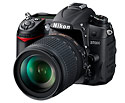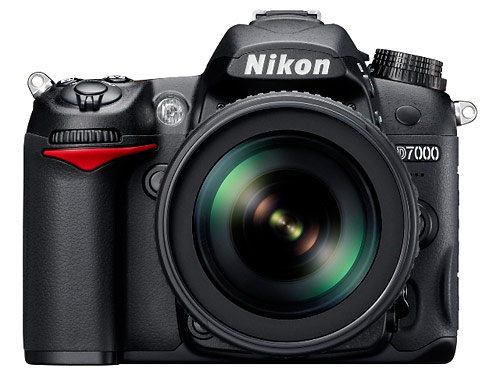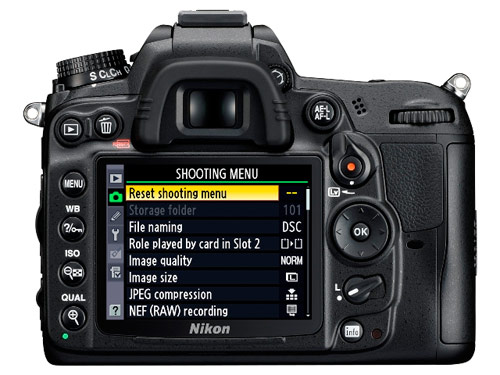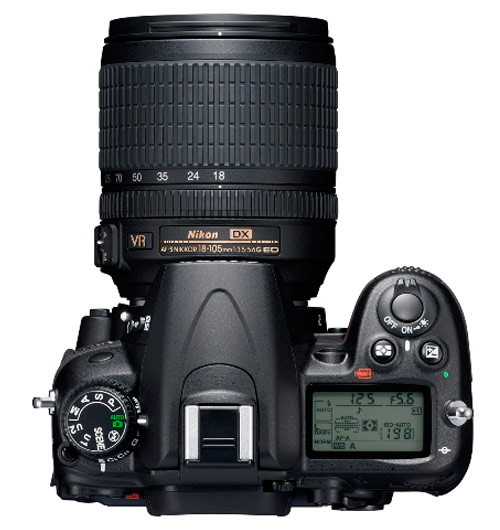 MELVILLE, N.Y. (September 15, 2010) – Nikon Inc. today introduced the new D7000 digital SLR camera designed to fulfill the needs of passionate photographers who demand exceptional performance, reliability, and unprecedented levels of control and versatility in a compact form factor. Engineered as an ideal balance of durability and functionality, the D7000 D-SLR features a multitude of new enhancements and updated Nikon technologies, which results in stunning photos and amazing full HD (High Definition) movies.
MELVILLE, N.Y. (September 15, 2010) – Nikon Inc. today introduced the new D7000 digital SLR camera designed to fulfill the needs of passionate photographers who demand exceptional performance, reliability, and unprecedented levels of control and versatility in a compact form factor. Engineered as an ideal balance of durability and functionality, the D7000 D-SLR features a multitude of new enhancements and updated Nikon technologies, which results in stunning photos and amazing full HD (High Definition) movies.
Continuing the tradition of innovative technology that began with the revolutionary D90, the first D-SLR to capture HD movie, the D7000 features a new 16.2-megapixel CMOS sensor with low-light ability never before seen in a DX-format (APS-C) camera. The new EXPEED 2 TM image-processing engine fuels the enhanced performance of the D7000 along with a new 39-point AF system and groundbreaking new 2,016 pixel RGB 3D Matrix Metering System to deliver amazing image quality in a variety of shooting conditions. Additionally, the D7000 D-SLR provides full 1080p HD movie capability with full-time auto focus (AF), enabling users to capture their world with both striking still and moving images.
“The D7000 D-SLR creates a new class of Nikon camera by delivering exceptional quality, control and an innovative feature set; this is a camera that enables D-SLR users to achieve a true expression of their creative vision, while concentrating primarily on image quality above all else,” said Lisa Osorio, general manager of marketing at Nikon Inc. “When you combine the innovation of the agile D7000 with the exceptional and robust line of NIKKOR lenses and accessories, the potential for D-SLR photographers and filmmakers is limitless.”
Unparalleled Performance From Unrivaled Technologies
With its new 16.2-megapixel CMOS image sensor and Nikon’s new EXPEED 2 image processing system, the D7000 D-SLR delivers superior image quality with low noise. The EXPEED 2 image-processing engine combined with a 14-bit Analog / Digital conversion brings a new level of even tonal gradations while managing color, contrast, exposure, and noise resulting in brilliant image quality. EXPEED 2 also manages the D7000’s speedy 50-millisecond shutter response, blazing AF speed and rapid six frame-per-second (fps) burst speed for up to 100 images.
The D7000 D-SLR features an all-new 39-point AF System, which includes nine center cross-type sensors that operate with more than 60 NIKKOR lenses. The 39 points in the new Multi-CAM 4800DX AF module work together to provide superior subject acquisition and fast tracking capabilities, allowing photographers to confidently capture a player stealing third from the sideline to fast-moving wildlife. Additionally, photographers can activate dynamic or single point AF, configurable in combinations of 9, 21 or 39 or a 21-point ring to match a variety of shooting styles and situations. Photographers can activate 3D tracking, which continuously follows moving subjects within the 39 AF points, highlighting the activated AF point in the viewfinder.
Utilizing Nikon’s exclusive Scene Recognition System, the camera analyzes subject information from a database containing more than 30,000 images to optimize focus, exposure and white balance. To assist in creating amazing imagery, the Scene Recognition System reads data from a groundbreaking 2,016-pixel 3D Color Matrix Meter RGB sensor that examines the scene’s brightness and color data then optimizes the camera’s performance prior to the actual exposure. Another revolutionary Nikon first, this system interprets scene data for improved control of light metering and i-TTL flash output. Additionally this new sensor allows for a new “Ambient” white balance setting which can be activated to allow warm rendering in Automatic White Balance.
Nikon Continues the Low-Light Fight
The D7000 D-SLR continues Nikon’s tradition of providing photographers the confidence to shoot in low-light, knowing they will capture high quality low-noise images. The camera’s native ISO range of 100-6400 affords the versatility to photograph in challenging lighting conditions, such as when indoors or in the evening. The ISO range can be expanded to a Hi-2 setting of 25,600, which was previously found only in Nikon FX-format territory. The resolution of the camera renders a pixel size of 4.78 µm, which allows more light to be gathered, resulting in a correctly exposed image that has less noise and finer grain.
Full 1080p HD Movies with Advanced Video Features
Building upon the popular D90 D-SLR, the Nikon D7000 captures breathtaking full 1080p HD movies with full-time autofocus and manual exposure control. To keep critical HD focus, users can choose to engage a variety of AF functions, including face priority to track up to 35 human faces, subject-tracking and normal or wide-area autofocus.
Advanced movie features also allow exposure adjustment on the fly while recording. The D7000 D-SLR offers variable frame rates and resolutions, and can record 1080p at a cinema-like 24 fps, or a web-friendly 720p at either 24 or 30 fps for up to 20 minutes per clip. Once recorded, users are able to edit and trim video clips in the camera to save time in post production. Whether utilizing a wireless or hot shoe mounted microphone, sound can be recorded via the stereo microphone input for professional audio results.
To further simplify movie shooting, Live View is activated by a single dedicated switch, and HD video recording is achieved by pressing a single button. The D7000 D-SLR also incorporates a built-in HDMI output CEC compliant (Consumer Electronic Control) that allows users to connect it to a HDTV and playback with most HDTV remote controls.
By adding versatile NIKKOR lenses to the equation, photographers can create a variety of photo perspectives to video such as isolating subjects with a shallow depth of field, and recording in low-light conditions. Combining the D7000 D-SLR with NIKKOR lenses also delivers the sharpness essential for HD video, and Nikon’s innovative Vibration Reduction (VR) II technology helps to eliminate the effects of camera shake.
No Compromise: Enhanced Build Quality, Durability and Usability
The compact design is lightweight enough for a full days use, but has a reassuring heft that hints at Nikon’s reputation for reliability. The durable camera body consists of a magnesium-alloy top and rear covers and a 150,000 cycle-rated shutter system. Additionally, the D7000 D-SLR is dust and moisture sealed and features Nikon’s dust reduction system to remove image-degrading particles from the image sensor. Among the well laid out ergonomics, users will immediately notice a new Mode Dial that eschews traditional Scene Mode icons for more advanced manual functions and two user-defined settings (U1, U2) to adapt to a users shooting style on the fly. Placed under the control wheel is a Release Mode dial, which allows access the burst modes, timer, or the Quiet Shutter, to soften the cameras operation when shooting in sensitive environments such as a ceremonies or nature.
When framing lush landscapes or tight telephoto shots from afar, users will appreciate the large, bright glass pentaprism optical viewfinder has approximately 100% frame coverage and approximately 0.94x magnification. The three-inch, 921,000-dot super-density LCD monitor with 170-degree viewing delivers bright, crisp image playback and precise Live View and movie shooting.
The D7000 D-SLR features twin SD card slots with SD, SDHC, SDXC memory card compatibility that offers several recording options including designating separate NEF (RAW) JPEG and movie files. The built-in i-TTL Speedlight flash offers coverage for lenses as wide as 16mm and has Wireless Commander support so users can choose how to light their subjects. The D7000 was designed to provide maximum performance with minimized power usage and also employs a new EN-EL15 battery which enables up to 1050 shots when fully charged.
Nikon Technologies That Empower and Inspire
The D7000 D-SLR contains many features aimed at empowering the user with creative freedom including the ability to process RAW images directly in the camera, and add in special effects using the retouch menu. Among the many editing options are color filters, distortion control for a fisheye effect, perspective control for a miniature effect, or a new color sketch filter that creates a sketch-styled image. As always, manipulated images are saved as copies while the original is retained.
The Picture Control system also allows the choice for Standard, Neutral, Vivid, Monochrome, Portrait, or Landscape settings to apply a personal look and feel to their pictures, and it’s versatile Scene Modes let them choose from Portrait, Landscape, Child, Sports, Close-up or Night Portrait for stunning results even in challenging conditions.
Price and Availability
The D7000 D-SLR camera will be available throughout the United States beginning mid-October 2010 at an MSRP* of $1199.95 for body only and $1499.95 for body and lens outfit that includes the AF-S DX Zoom-NIKKOR 18-105mm f/3.5-5.6G ED VR lens. For more information, please visit www.nikonusa.com.
Related Content:
Nikon Review Page
Nikon Cameras Forum
Digital SLR Forum
More Nikon News And Articles
Nikon Web Site





I’ve seen one complaint about this camera on the Web sofar. That is that it doesn’t have good bracketing specs, which makes it a poor camera for HDR photographers.
The D700 manual has the same misprint the D90 manual has about HDR specs. In reality it will give the same 2EV spread as a D90 making it a good HDR camera.
Edit to the above comment – meant to say the D7000 manual, not D700.
I think the forthcoming Pentax K-5 is going to give all cameras in this category a run for their money
Great review, very informative. This is a very interesting development from Nikon, thanks for sharing.
I made a short review video of this camera from Photokina on behalf of http://www.convergeevents.co.uk.
Keep up the good work!
What, no mention of the Pentax K-5! I think PR is trying to promote the Nikon 7000 without even mentioning its direct competition, the Pentax K-5. PR, you should be ashamed of showing your bias towards Nikon when the Pentax K-5 has better specs than the Nikon 7000! Shameful display of accolades and bias!
Be serious, the Pentax sensor can’t handle High ISO like the Nikon D7000 :O
I can not wait to get my hands on this camera. Although having video has always been useless for me being a photographer, I think I may start to have some fun with it.
As for this being a bias review? I don’t think it is, I read plenty of reviews on this site, and I have never found one to be bias, sure the Pentax K-5 may be a good competitor, but this article is on the Nikon D-7000 and its performance.
Great review.
Dave – A Pentax camera isn’t going to give a Nikon or Canon camera a “run for their money” no matter what camera Pentax produces. It’s all about the “system” behind the camera body. Until Pentax creates glass and strobes that complete a high quality high quality camera body, Pentax will primarily be a consumer camera.
You can say that this is in the advanced amateur category, but it has better features than the Nikon D300s and maybe the D700.
you should be ashamed of not showing the side view of the camera. shameful, shameless, shame shame shame….lol.
Great review. Keep up with your great articles.
What is alll the hype all about. The D3000rovskirk attributesS is still superior…
Harris-
You had me there for a second, buddy
Anthony-
The D3000 or the D300? The D3000 is *not* superior.* The D300s is better in some ways but not all. For people interested in video, the D7000 is most assuredly a better camera. And the image quality should be better for stills and video.
I just noticed Donna’s comment that suggested I have a Nikon bias. This is probably somewhat true, although it would be an unintentional bias based more on the popularity of Nikon than anything else. I’ve actually quite enjoyed my time with Pentax DSLRs and my very first 35mm SLRs were Pentax cameras, back in the 80s. So I don’t have anything against Pentax. They just really aren’t that competitive right now as far as the number of people using their cameras. It’s also been very difficult for me to get review cameras from Pentax and that makes it hard for me to keep them on my radar.
The bottom line with the D7000 is that for a couple of years now Nikon has produced the DSLRs with the best image quality. There’s no way around that. That doesn’t belittle the quality other cameras produce – there are no bad digital SLRs anymore. But I stand by my claim that the D7000 is the “category crusher.” It’s already taken over the top spot as most popular camera on the site, knocking the D90 off the pedestal.
Rick — Pentax produces great professional level glass. Their unique, jewel-like prime lenses are unlike anything Nikon or Canon offer. They don’t have some niche glass covered, but, eh, that doesn’t mean they can’t compete in this category. The flash system isn’t up to Nikon’s, but again, in this category, it’s good enough.
Photo-John: I know it’s hard to keep up with all of the smaller brands, but do yourself a favor and check out the K-5. The D7000 basically plays out like a homage to the Pentax K-7, with some cost-cutting measures (check out an internal diagram of the D7000′s magnesium body) and with a newer, better sensor. The Pentax K-5 uses basically the same sensor as the D7000, but doesn’t go for the cost-cutting (and in fact makes some nice improvements over the K-7).